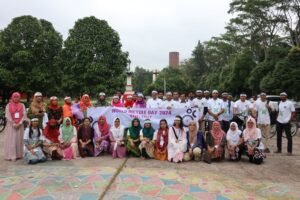The term “Yoga” or “Yog” originates from “Yuj,” a Sanskrit term meaning “to join” or “to unite.” It is a practice facilitating an individual’s connection with their inner mind or consciousness, fostering harmony between the body and soul. Through regular practice, Yoga cultivates physical fitness, breath awareness, mental connection, and inner self-awareness. Today, Yoga is globally embraced, benefiting millions by promoting physical wellness and inner peace.
In contemporary society, women are multifaceted individuals, balancing various roles beyond traditional household duties. As mothers, sisters, wives, and independent professionals, they tirelessly strive to harmonize home and career. Recognizing women as the societal bedrock underscores the imperative of nurturing their mental and physical well-being. Understanding the pivotal role of women’s health is crucial for fostering robust communities.
Women serve as the linchpins of familial health, impacting the well-being of spouses, children, and communities. Neglecting their own health while prioritizing the needs of others can lead to detrimental consequences. Acknowledging the interconnectedness of personal health and familial vitality is paramount for women’s holistic wellness.
Historically, women’s roles were confined to domestic responsibilities, devoid of educational and professional opportunities. However, societal shifts have propelled women into diverse spheres, often requiring prolonged sedentary work hours. This transition underscores the necessity of incorporating physical activity into busy lifestyles.
In essence, recognizing the evolving landscape of women’s roles underscores the importance of prioritizing their health amidst myriad responsibilities. Through initiatives such as Yoga, women can cultivate resilience, vitality, and holistic well-being, enriching both individual lives and societal fabric.
Steps to Improve Women’s Health
In our fast-paced lives filled with unhealthy eating habits, a myriad of diseases and lifestyle issues have become prevalent, affecting many women. Among these, conditions such as PCOS and infertility have become increasingly common, highlighting the need for proactive health measures. With approximately 23% of urban Indian women classified as obese, it is imperative to adopt the following steps to enhance overall health:
- Balanced Diet: Prioritize home-cooked meals over processed or ready-to-eat foods to ensure adequate nutrition and support optimal health.
- Regular Exercise: Allocate at least 30 minutes each day to physical activity, whether it’s walking, gym workouts, Zumba, or any other form of exercise to promote fitness and vitality.
- Yoga: Contrary to misconceptions, yoga offers numerous benefits for women’s health. Research from the National Center for Biotechnology Information indicates that 92.16% of individuals practicing yoga experience positive lifestyle changes. Incorporating yoga into daily routines fosters mental peace, improves blood circulation, enhances mindfulness, boosts metabolism, aids digestion, and facilitates weight loss.
- Meditation: Engage in regular meditation sessions to reduce stress, alleviate anxiety, and enhance overall mental well-being.
- Hydration: Maintain adequate hydration levels by consuming an ample amount of water daily. Proper hydration not only detoxifies the body but also optimizes brain function and prevents kidney stones.
- Work-Life Balance: While pursuing a career is commendable, it’s essential to strike a balance between professional obligations and personal well-being. Allocate time for family, leisure activities, and vacations to rejuvenate and enhance productivity.
Yoga: An Ancient Blessing
Yoga, an ancient practice, has experienced a resurgence in popularity worldwide. Whether practiced at home, in an ashram, or even in the office, yoga emphasizes inner self-awareness and holistic well-being through pranayama (breathing exercises), asanas (yoga postures), and savasana (resting period). Regular yoga practice not only promotes mental tranquility but also enhances blood circulation, increases mindfulness, boosts metabolism, aids digestion, and facilitates weight loss.
For women juggling various roles and responsibilities, yoga serves as a blessing, offering a reprieve from the constant hustle and bustle of daily life. Simple breathing exercises help women manage stress gracefully, fostering a balance between body and soul. By integrating yoga into their daily routines, women can experience profound benefits for their physical, mental, and emotional health.
Yoga for Women’s Health and Fertility
Recognizing the significance of yoga in women’s health and community well-being, let’s explore a few asanas and their benefits for women:
- Paschimottanasana (Seated Forward Bend): This asana aids in losing tummy fat, stretching shoulder and back muscles, alleviating hamstring pain, calming the nervous system, treating high blood pressure and infertility, and toning internal organs.
- Veerabhadrasana (Warrior Pose): Enhances body awareness, balance, and strengthens back, hamstring, and shoulder muscles and joints.
- Marjiarasana (Cat/Cow Pose): Improves spine flexibility, massages internal organs for better digestion and metabolism, and relaxes the mind while strengthening wrists and shoulders.
- Shishuasana (Child Pose): Relaxes muscles, eliminates back and neck pain, and rejuvenates the body through gentle stretching and massaging of internal organs.
- Ardha Chakrasana (Standing Backward Bend): Provides a full-body stretch, tones arm and shoulder muscles, alleviates lower back pain, and aids in respiratory health.
By incorporating these yoga asanas into their regular practice, women can nurture their physical health, enhance fertility, and achieve holistic well-being.
Hastapadasana (Standing Forward Bend)
Following a backward bending asana, it’s advisable to practice a forward bending pose to induce relaxation. To perform this asana, stand with feet together and hands resting by the sides. Inhale deeply and raise both hands overhead. Upon exhaling, bend forward from the hips, aiming to touch the floor or ankles with the hands while attempting to bring the head closer to the knees. Hold the position for approximately 10 seconds before repeating. This asana stretches nearly all muscle groups, enhances spinal flexibility, and promotes increased blood circulation. It’s important to note that individuals with low back injuries, cervical pain, spinal issues, or Spondylitis should refrain from practicing this pose.
Utkatasana (Chair Pose)
The chair pose presents an intriguing yet demanding posture, simulating the act of sitting in a chair. Although seemingly straightforward, maintaining this pose can be challenging for many. Begin by standing straight with arms alongside the body. Extend the arms forward without bending the elbows, then proceed to bend both knees while envisioning sitting on an imaginary chair. Ensure that the hands remain parallel to the floor and avoid slouching. Utkatasana tones the ankles, thighs, legs, and knees, while also serving as an effective exercise for the spine, hips, and chest muscles. It enhances overall body balance. Individuals with chronic knee pain, arthritis, or a sprained ankle should avoid attempting this posture.
Yoga Nidra (Yogic Sleep)
Yoga Nidra, often practiced towards the conclusion of a yoga session, offers the ultimate relaxation. Lie down flat on a mat, close the eyes, and focus on relaxing the entire body. This pose facilitates the absorption of the effects of preceding yoga postures by the nervous system.
Baddha Konasana (Butterfly Pose)
The Butterfly pose is a seated asana involving sitting with a straight back and joining the soles of the feet together while holding them with the hands. Bring the feet as close to the inner thighs as possible. Begin gently moving the knees up and down, mimicking the wings of a butterfly. This asana provides an excellent stretch to the inner thighs, groin, and knees, while also aiding in intestinal and bowel movement. Pregnant women and those planning to conceive benefit greatly from this pose as it enhances fertility and supports smooth pregnancy. However, individuals with chronic knee pain or groin injuries should avoid practicing this pose.
Conclusion
Yoga and meditation offer simple yet immensely beneficial exercises that require minimal equipment. All that’s needed is a yoga mat and the dedication to practice regularly. With consistent effort, yoga can lead to transformative physical, mental, and spiritual changes, fostering a profound connection between the body, mind, and the divine. Let’s embrace the power of yoga and embark on a journey of personal transformation and wellness.








